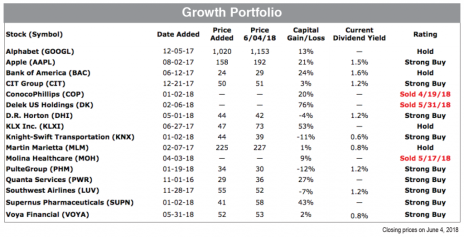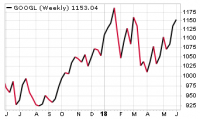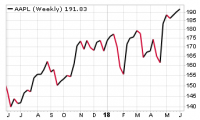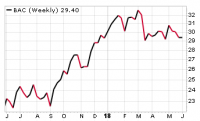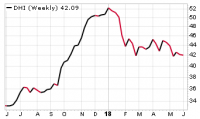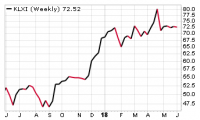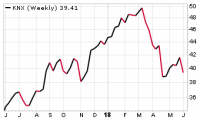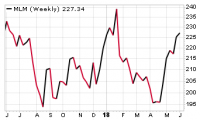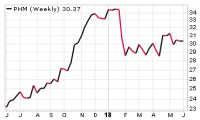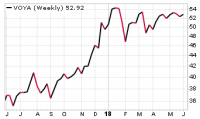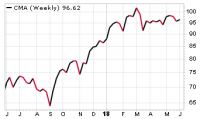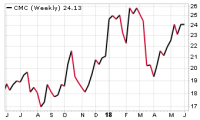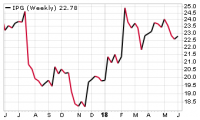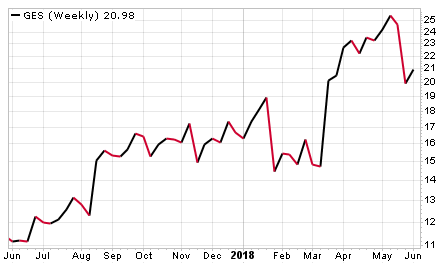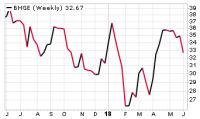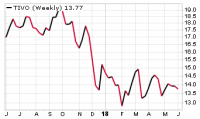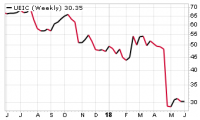The introduction features a few international trade issues, including disputes about international court systems within NAFTA and CETA, and a potential sunset clause in NAFTA. I’d go on to itemize which steel companies might benefit or be harmed by the latest round of steel tariffs, but I frankly believe that last week’s newest steel tariffs are simply a temporary negotiating ploy pertaining to NAFTA. Therefore, I thought it might be more useful to discuss what’s currently happening with NAFTA negotiations.
Cabot Undervalued Stocks Advisor 618
[premium_html_toc post_id="151237"]
News About International Trade Negotiations and NAFTA
The vast majority of Americans are not exposed to what’s happening in international trade negotiations, simply because the topic is too extensive to be covered by common news sources. So instead, Americans receive sound bites amounting to approximately two sentences that throw around words like “protectionism” and “tariff” without conveying any sense at all about what is being agreed to and/or opposed by trade negotiators. Since I have access to news sources that most of you never see, I thought I might just list a few facts about what’s happening with the North American Free Trade Agreement (NAFTA).
One of the big sticking points in NAFTA is that the U.S. wants to add a five-year sunset clause, whereas Canada does not want to do so. The sunset clause would require NAFTA to be renegotiated every five years, so that problems that arise regarding the trade agreement’s effects on various parts of the three countries’ economies can be periodically ironed out. I think that sounds incredibly reasonable. Would you permanently agree to something that’s very complicated, which involves many people’s cooperation and affects your personal livelihood, knowing in advance that you might never be allowed to renegotiate the ensuing problem areas?
Could it be true that the U.S.-imposed Section 232 steel tariffs on Canada and Mexico were intended to put pressure on those nations to negotiate further on NAFTA topics that are currently stonewalled? Absolutely. I certainly do not believe that last week’s new tariffs had anything to do with steel, steelworkers, the Rust Belt or protectionism. I believe that steel is simply a pawn in this game, interchangeable with pharmaceuticals or textiles or IP.
Do I agree with that negotiation method? My opinion doesn’t matter. I’m more interested in facts and outcomes; I’m not privy to everything that takes place behind closed doors; and I ignore the media hype and personalities involved. Herein, I’m simply reporting on topics that you’re probably not otherwise exposed to. They’re messy. But it’s important to understand that the status quo was also messy, with trouble brewing for decades. You simply weren’t bombarded with that news every day like you are in 2018.
Ironically, Inside U.S. Trade reported on June 1, “French President Emmanuel Macron earlier this week called on the U.S., the EU and China to come together and design a ‘complete update’ of WTO rules.” The World Trade Organization’s (WTO) Director-General Azevêdo called Macron’s request “comforting” and noted it was “exactly the kind of political leadership that we need.” I find it somewhat laughable that the concept of updating rules and regulations and trade agreements can be lauded or reviled, depending on who is proposing the updating! I agree with Director-General Azevêdo, with French President Macron and with U.S. Commerce Secretary Wilbur Ross that periodically updating institutions and agreements devoted to international trade is a good idea.
Also controversial is the current Investor-State Dispute Settlement (ISDS) mechanism within NAFTA. ISDS, which is a common component within many trade agreements, has ended up dismaying many political and business leaders and diplomats. (When I worked in international trade, opposition to ISDS came from the political left, right and center.) The function and decisions of the dispute panels have turned out to be occasionally shocking and often unacceptable to countries that are otherwise accustomed to their own judicial systems’ checks and balances, unbiased judges and appeal processes. (You can read more about objections to ISDS in this letter to Congress signed by 220 law and economics professors in September 2016.) The U.S. is seeking to change this facet of NAFTA, while Canada and Mexico oppose the suggested changes.
The Comprehensive Economic and Trade Agreement (CETA) between the EU and Canada, which was ratified by European Parliament in September 2017 and provisionally implemented, must also be ratified by the EU Member States. The big sticking point is the trade agreement’s Investment Court System (ICS) – similar to NAFTA’s ISDS – which ostensibly conflicts with EU law, and contains other problematic aspects that remain highly controversial. (I did extensive reporting on the problems associated with the international court provisions of trade agreements, several years ago; the point being that trade agreements are far more complicated than you will ever hear on the nightly news. Clearly, there’s more to a document such as the Trans-Pacific Partnership (TPP) trade agreement, which was over 5,000 pages long, than just “protectionism” and “tariffs”.)
In the coming days and weeks, it will not be surprising to learn that diplomats from Canada and Mexico agree to further discuss NAFTA’s sticking points, and for the U.S. to therefore cease implementing Section 232 steel tariffs. I’m sure the media will portray such a scenario as one of President Trump being double-minded. I will believe, however, that it’s all a chess match between experienced opponents who are each relishing the game, trying to achieve the best deal for their respective countries, and being promoted by their public relations teams.
Send questions and comments to crista@cabotwealth.com.
Portfolio Notes
Be sure to review the Special Bulletins from May 31 and June 1 in which I mentioned news, rating changes and/or price action on Blackstone Group (BX), Delek U.S. Holdings (DK), Guess?, Inc. (GES), Knight-Swift Transportation (KNX), PBF Energy (PBF) and Voya Financial (VOYA).
Buy-Rated Stocks Most Likely* To Rise More Than 5% Near-Term:
Alexion Pharmaceuticals (ALXN)
Apple (AAPL)
Commercial Metals (CMC)
Guess? (GES)
PulteGroup (PHM)
Supernus Pharmaceuticals (SUPN)
*I can review price charts and make an educated determination about what’s likely to occur, but I will sometimes be wrong. I cannot control the stock market; I can only guide you through it.
Today’s Portfolio Changes:
DowDuPont (DWDP) joins the Growth & Income Portfolio as a Strong Buy.
Martin Marietta Materials (MLM) moves from Buy to Hold.
Schlumberger (SLB) moves from Buy to Strong Buy.
Supernus Pharmaceuticals (SUPN) moves from Buy to Strong Buy.
Last Week’s Portfolio Changes:
Delek U.S. Holdings (DK) moved from Hold to Sell.
Guess?, Inc. (GES) joined the Buy Low Opportunities Portfolio as a Strong Buy.
PBF Energy (PBF) moved from Hold to Sell.
Voya Financial (VOYA) joined the Growth Portfolio as a Strong Buy.
Growth Portfolio
Growth Portfolio stocks have bullish charts, strong projected earnings growth, little or no dividends, low-to-moderate P/Es (price/earnings ratios) and low-to-moderate debt levels.
Featured Stock: Southwest Airlines (LUV - yield 1.2%)
Southwest Airlines is the largest U.S. domestic air carrier, transporting over 120 million customers annually to over 100 locations in the U.S., Central America and the Caribbean. On the Investor Relations page of Southwest’s website, you may access the company’s 33-page Investor Presentation Booklet that clearly demonstrates Southwest’s financial successes, operational strengths and competitive advantages. Amusingly, page 4 lists 17 of its U.S. competitors’ bankruptcies in the years 2000 through 2011, while Southwest Airlines has been profitable for 45 consecutive years.
The biggest question in the airline space has been whether airlines will slow their capacity growth (a good thing) in light of the increase in the price of oil. Thus far, Southwest, Spirit Airlines (SAVE) and Alaska Air Group (ALK) have trimmed their schedules.
From the look of the recent price chart, you might surmise that Southwest’s financial outlook has taken quite a hit. In fact, LUV is an undervalued stock that’s experiencing aggressive earnings growth. Analysts expect EPS to grow 26.9% and 17.1% in 2018 and 2019. The corresponding P/Es are 11.6 and 9.9.
Last month, Southwest raised its quarterly dividend by 28%, from 12.5 cents to 16.0 cents per share. For comparison, American Airlines (AAL) has no recent history of raising its dividend, while Spirit Airlines and United Continental Holdings (UAL) pay no dividends at all.
Southwest repurchased 15% of its basic outstanding shares in the four years ending December 2017. In May, the company increased its repurchase program by $2 billion, in addition to the $350 million remaining in last year’s repurchase authorization, representing another 8% of the company’s shares. Share repurchases generally serve to support the share price, increase earnings per share (EPS), and also attract new buyers who can drive the share price higher.
Southwest’s long-term debt-to-capitalization ratio is just 24%. For comparison, American Airlines and United Continental Holdings have debt ratios of 77% and 54%, respectively. The more debt a company has, the less flexibility they have to effectively run their business. Every dollar spent on debt service is a dollar that’s not allocated to improving operations, funding pension plans, increasing salaries, hiring new employees, or business expansion.
In May, stock market performance of the major U.S. airlines ranged from +1% to -8%, so while LUV did not deliver capital appreciation to investors, neither did its peer group. Now that the price of oil is temporarily receding, we’re starting to see some signs of life in airline stocks. It should be noted that Southwest has a well-hedged fuel position, so despite investors’ worries about oil prices and airlines, Southwest is still thriving financially.
LUV is trading at a solid support level that dates back to December 2016. There’s 18% upside to the March high of 61, and 28% upside to the January high of 66. This is a good time for traders and longer-term investors to make sure they’re positioned to catch the rebound in the share price. Buy LUV now. Strong Buy.
Updates on Growth Portfolio Stocks
Alphabet Cl. A (GOOGL) is the world’s largest internet company. Alphabet’s Waymo subsidiary, an autonomous car development company, announced an agreement with Fiat Chrysler on June 1 to add up to 62,000 Chrysler Pacifica Hybrid minivans to Waymo’s self-driving fleet. Consider the possibility that Alphabet might spin off Waymo in order to keep any legal liability associated with autonomous cars attached to Waymo and separated from Alphabet.
Revenue is derived from Google’s online ads, with the balance coming from the sale of apps, digital content, services, licensing and hardware. Alphabet’s 2019 EPS are expected to grow just 7.2%, while the 2019 P/E is much higher at 23.9. That’s not an attractive growth or value situation. GOOGL is now rising rapidly toward price resistance at 1,190, where I plan to sell. Hold.
Apple (AAPL – yield 1.5%) manufactures a wide range of popular communication and music devices. Apple’s annual Worldwide Developers Conference began June 4, and will likely showcase major software announcements and hardware upgrades. Revenue and margin increases at Apple Services (Apple Music, the App Store, etc.) are expected to drive corporate growth for years to come. AAPL is an undervalued growth stock, expected to see EPS increase 24.8% and 15.3% in fiscal 2018 and 2019 (September year-end). The corresponding P/Es are 16.6 and 14.4. Last week, UBS raised their price target for AAPL from 190 to 210. AAPL rose to a new all-time high in May, rested a bit, and now appears to be commencing a run-up. Buy AAPL now. Strong Buy.
Bank of America (BAC – yield 1.6%) is an undervalued growth stock. BAC is sitting near recent lows, but could retrace its recent high near 33 this summer, where I will likely sell in favor of a small bank or property & casualty insurance company. Hold.
CIT Group (CIT – yield 1.2%) operates both a bank holding company and a financial holding company that provide financing, leasing and advisory services to small and middle market businesses, consumer markets, and the real estate and railroad industries. New banking legislation will roll back some post-crisis financial regulations that had greatly harmed small- and mid-cap banks. As a result, CIT is very likely to release excess capital to shareholders, according to Barron’s. CIT Group’s CEO will present at the Morgan Stanley Financials Conference on June 13. The number of analysts contributing to consensus earnings estimates for CIT Group changes almost weekly, which is slightly unusual. Thus, there’s more volatility to the earnings estimates than with other companies. Analysts now expect EPS to grow 25.4% and 24.7% in 2018 and 2019. The corresponding P/Es are quite low at 13.3 and 10.7. CIT fell an exaggerated amount with bank stocks last week, and is already on the mend. There’s short-term price resistance at its March all-time high near 56. Strong Buy.
D.R. Horton (DHI – yield 1.2%) is America’s largest homebuilder, based in Ft. Worth, TX and operating in 26 states. The company also provides mortgage, insurance and title services. After achieving 16.9% earnings growth in 2017 (September year-end), D.R. Horton is expected to see EPS grow 33.6% and 19.7% in 2018 and 2019. Price/earnings ratios (P/E) remain low at 11.4 and 9.5 for fiscal 2018 and 2019. There’s 25% upside when DHI rebounds toward 53, where it peaked in January. Strong Buy.
KLX Inc. (KLXI) — Refer to the Special Bulletins from May 2 and May 7 in which I described the KLX decisions to allow Boeing (BA) to acquire its Aerospace Solutions Group (ASG), and to spin off its Energy Services Group (ESG) to shareholders. At a current price of $72.5 per KLXI share, minus the value of the Boeing-ASG transaction at $63, the market is valuing the rapidly-growing and profitable ESG business at $9.5 per share.
If you own KLXI and wait for the two M&A transactions to take place, you will have $63 cash per share returned to you, and you will own shares of the new KLX Energy Services (KLXE). The Boeing cash transaction is expected to be completed by September 1, and the KLXE spin-off could happen at any point between now and the completion of the Boeing transaction. (You are free to sell KLXI on any business day prior to the spin-off and prior to the completion of both transactions. You could, for example, receive the spin-off shares in July, at which time your remaining shares of KLXI will trade near $63 until the Boeing transaction is completed. You could sell your remaining KLXI shares on the open market, or just wait for the Boeing transaction to be completed, at which time the cash should show up in your brokerage account.)
Note that if you own KLXI in a taxable account, the KLXE spin-off will be a taxable transaction. The income tax reporting will either be slightly complicated for you, or slightly expensive if you’re paying an accountant an hourly rate to research the situation. An alternate strategy that avoids complicated tax reporting would be to sell KLXI before the KLXE spin-off, and consider buying KLXE immediately after the spin-off.
KLXI can potentially rise to 80 this summer, reflecting a more fair value of the KLXE spin-off. Please visit the KLX website and view the webcast and slide presentation to learn more about KLX’s rapidly-growing ESG business. Hold.
Knight-Swift Transportation Holdings (KNX – yield 0.6%) is a truckload carrier formed from the September 2017 merger between Knight Transportation and Swift Transportation Company. From June 5 through June 7, Roadcheck 2018 takes place, specifically focused on truck drivers’ potential hours of service violations. During the Roadcheck 2017 event, over 62,000 commercial motor vehicles were inspected for safety violations and drivers’ compliance with regulations. KNX is an undervalued mid-cap aggressive growth stock. Analysts expect full-year EPS growth of 67.4% and 18.6% in 2018 and 2019. The corresponding P/Es are 18.0 and 15.2. The stock gave back its recent gains yesterday, which I perceive as a very temporary delay on the road to retracing its 2018 high of 50. Buy KNX now. Strong Buy.
Martin Marietta Materials (MLM – yield 0.8%) is a supplier of crushed stone, sand, gravel, cement, concrete and asphalt. Earnings estimates continue to rise. Analysts now expect full-year EPS growth of 27.6% and 23.0% in 2018 and 2019. The corresponding P/Es are 24.6 and 20.0. MLM rose about 15% in May. I’m moving MLM from Buy to Hold now that it’s nearing its January peak at 240. Hold.
PulteGroup (PHM – yield 1.2%) is a U.S. homebuilder and a very undervalued aggressive growth stock. PulteGroup management will present at the Deutsche Bank 2018 Global Industrials and Materials Summit on June 6. Consensus earnings estimates reflect 60.7% and 12.4% EPS growth in 2018 and 2019. The corresponding P/Es are 9.2 and 8.2. If you glance at the six-month price chart on PHM, you’ll see an interesting pattern showing the stock moving two-steps-forward and one-step-back repeatedly since February, with each upward move reaching about $0.50 higher than the last upward move. In keeping with that trend, the stock will likely reach 32 quite soon, with additional gains as the months pass. Buy PHM now. Strong Buy.
Quanta Services (PWR) provides specialized infrastructure and network services to the electric power, oil and natural gas industries. Quanta Services’ management will meet with institutional investors at the Deutsche Bank Global Industrials & Materials Summit on June 6 and again at the Stifel 2018 Cross Sector Insight Conference on June 13. PWR is an undervalued mid-cap growth stock. Wall Street expects EPS to grow 39.6% and 14.9% in 2018 and 2019. The corresponding P/Es are 13.1 and 11.4. PWR rose rapidly in early May, then pulled back a bit. I expect PWR to rise to its January high of 40, with additional capital gains thereafter. Buy PWR now. Strong Buy.
Supernus Pharmaceuticals (SUPN) focuses on the development and commercialization of products for the treatment of central nervous system diseases and psychiatric disorders, including epilepsy, migraine and ADHD. Supernus management will present at the Jefferies 2018 Global Healthcare Conference on June 5. SUPN is an undervalued, small-cap stock with a high degree of institutional ownership. Analysts expect full-year EPS to grow 50% and 37.0% in 2018 and 2019, with corresponding P/Es of 30.5 and 22.4. After reaching a new all-time high in May, SUPN had a brief pullback. Since there was no major price correction, and SUPN seems capable of reaching new highs again quite soon, I’m moving the stock from Buy to Strong Buy. Strong Buy.
Voya Financial (VOYA – yield 0.08%) is a retirement, investment and insurance company serving approximately 14.7 million individual and institutional customers in the United States. This Fortune 500 company manages $541 billion in assets.
On June 1, in conjunction with the completion of the sale of their annuity business, Voya announced a new authorization to repurchase $500 million of its stock during the second half of 2018. The company recently repurchased $1 billion of its stock since the fourth quarter of 2017, representing 10% of outstanding shares. In summary, it’s highly unusual for a company to repurchase such a large percentage of its common stock within a short time frame, which directly serves to enhance the value of the remaining shares. The repurchase activity at Voya is at least as bullish for a company with a market cap of $8.9 billion as Apple’s (AAPL) recently-announced $100 billion share repurchase authorization was for a company with a $935 billion market cap.
Voya is well into a multi-year process of improving its business operations and profitability, and lowering its risk. The sale of the majority of the company’s variable and fixed annuity operations was completed on June 1 – the day after VOYA joined the Growth Portfolio. The sale of Voya’s life insurance segment is also a possibility. In addition, management is focused on expanding the company’s return on equity (ROE) to a range of 13.5% to 14.5% by 2019, and has thus far been reaching ROE milestones ahead of schedule. Wall Street projects Voya’s earnings per share (EPS) to grow 119% and 25.4% in 2018 and 2019. The corresponding price/earnings ratios (P/Es) are 12.5 and 10.0.
After a big run-up in its share price, VOYA has traded sideways for six months, with the trading range narrowing toward the upper end of the range. VOYA appears capable of rising past 55 to new all-time highs in the near term. Buy VOYA now. Strong Buy.
Growth & Income Portfolio
Growth & Income Portfolio stocks have bullish charts, good projected earnings growth, dividends of 1.5% and higher, low-to-moderate P/Es (price/earnings ratios), and low-to-moderate debt levels.
Featured Stock: DowDuPont (DWDP – yield 2.3%)
The Dow Chemical Company (DOW) and E.I. du Pont de Nemours & Company (DD) finalized their merger on August 31, 2017, forming DowDuPont, which is comprised of three divisions: Agriculture, Materials Science and Specialty Products. The Agriculture Division includes DuPont Pioneer, DuPont Crop Protection and Dow AgroSciences. The Materials Science division focuses on plastics and chemicals, and the Specialty Products division focuses on technology-driven specialty businesses. DowDuPont intends to separate these divisions into three publicly-traded companies, with current target dates of approximately April and June 2019. Once the companies are separated, institutional investors will be able to more effectively compare the successes and balance sheets of the new Materials Science company to competitor LyondellBasell Industries N.V. (LYB), allowing the new stock to rise to a more comparable valuation to LYB.
DWDP shares have underperformed their chemical company peer group since the merger, which is not only not surprising to me, but part of the very reason that I’m ready to buy the stock today. It’s typical that after big company mergers, the new stock languishes for quite a few months. My theory is that Wall Street analysts want to see a couple of quarters of combined financial results, and get comfortable with the new company’s longer-term prospects, before sticking their necks out and giving their institutional clients a green light on buying the stock.
I’ve recommended similar post-merger stocks in the Cabot Undervalued Stocks Advisor portfolios in the past, including Dollar Tree (DLTR) after it bought Family Dollar Stores (FDO), and Kraft Heinz (KHC) after its merger. Both companies coincidentally merged in July 2015 and I bought them each nine months later in April 2016. DLTR delivered an annualized total return of 9.9%, and KHC delivered an annualized total return of 26.8%. It’s now nine months since the DowDuPont merger, and that seems to be the sweet spot with regard to timing a purchase before everybody on Wall Street finally catches on that the merger was financially successful.
Consensus estimates, derived from two dozen Wall Street analysts, point to DowDuPont seeing profits growing aggressively at 23.8% and 17.5% in 2018 and 2019. Those are huge numbers for a company with a market cap of $154 billion! The respective price/earnings ratios (P/Es) are 16.1 and 13.7.
DowDuPont is currently paying a dividend yielding 2.3%. I don’t have a sense of whether that dividend will be increased prior to the stock spin-offs.
The long-term debt ratio is quite low at 21%—unusual after a big merger that typically increases corporate debt.
The stock fell about 20% this year with the correction in the broader market, and did not recover promptly, thus providing the buying opportunity that we’re taking advantage of today. DWDP is a very gradual uptrend right now, and could retrace its January high of 76 in the coming months, giving new investors a potential 13% profit. I expect additional capital appreciation after the stock rests near 76 for a while, and additional gains as the spin-offs add to the total return. Buy DWDP now. Strong Buy.
Updates on Growth & Income Portfolio Stocks
BB&T Corp. (BBT – yield 2.8%) is a 145-year-old financial holding company with $222 billion in assets and 2,100 financial centers that serves businesses and individuals. BB&T is in a multi-year cycle of increasing its net interest margin (NIM) as the company earns higher income from investments and its growing loan portfolio, while keeping costs down via an increase in non-interest bearing deposits and extending maturities on lower-yielding CDs. BB&T is expected to commence with M&A activity by buying a smaller bank within its region shortly after BB&T is in compliance with new bank legislation and its related requirements. Earnings estimates have slowly risen all year. Analysts now expect full-year EPS to grow 43.7% and 8.5% in 2018 and 2019, with corresponding P/Es of 13.3 and 12.2. The ex-dividend date was May 10. BBT fell a bit with bank stocks last week, and appears capable of reaching price resistance at 55.5 quite soon. Hold.
Blackstone Group LP (BX – yield 7.7%*) is the world’s largest and most diversified alternative asset manager with $450 billion in client assets. The company raises tens of billions of dollars from investors and deploys the capital into private equity, lower-rated credit instruments, hedge funds and real estate. Credit Suisse commented in late May that if Blackstone Group follows KKR & Co.’s (KKR) lead, and converts from a partnership to a C-corp. in 2019, the value of BX shares could rise 50%. Analysts expect Blackstone’s economic net income (ENI) to grow 2.8% and 11.8% in 2018 and 2019, with corresponding P/Es of 11.2 and 10.0. BX is rising toward its March high of 34. There’s additional price resistance at 35.5 from January. I agree that conversion to a C-corp. could deliver additional large capital gains. Buy BX now. Strong Buy.
*The payout varies each quarter, with the total of the last four announced payouts, plus the $0.30 special 2018 distribution, yielding 7.7%.
Comerica (CMA – yield 1.4%) is a financial services company engaged in domestic and international business banking & lending, wealth management and consumer services. The company is in a strong position to capitalize on rising interest rates that contribute to increases in net interest margin (NIM) through its variable rate loan portfolio (90% variable rate vs. 10% fixed rate loans). Comerica is expected to increase EPS by 40.8% and 11.6% in 2018 and 2019. The corresponding P/Es are 14.3 and 12.8. The ex-dividend date is June 14. CMA fell a bit with bank stocks in late May, and is already rising again. The stock could surpass 102 to new all-time highs fairly soon. I will likely sell CMA after that run-up, due to fair valuation. Hold.
Commercial Metals Company (CMC – yield 2.0%) is a recycler and manufacturer of steel and metal products, including rebar and fence posts. U.S. industrywide pricing is expected to remain strong due to robust economic activity, lower steel supply, and lower import volumes due to tariffs. Steel stocks fell in March when new tariffs on steel imports were announced, and then the shares rose last week when new tariffs on steel imports were again announced. (Yes, that makes no sense. Stock market action often does not make sense, thus providing investors with buying opportunities!) CMC benefits from the earlier tariffs on Turkish steel imports and the new tariffs on Canadian and Mexican steel imports. (Not all U.S.-based steel producers benefit from the Section 232 steel tariffs.) Be aware that progress within the final NAFTA negotiations could serve to remove the steel tariffs, because the current round of tariffs might be an “encouragement” to Mexico and Canada to play more fairly re: NAFTA automobile rules of origin and the Investor-State Dispute Settlement portion of NAFTA.
Consensus earnings estimates have been rising intermittently since late March. Wall Street analysts now expect EPS to grow 100% and 66.9% in 2018 and 2019 (August year-end), with corresponding P/Es of 17.0 and 10.2. CMC is racing back to its 2018 high of 26. CMC is an extremely undervalued aggressive growth stock, and I plan to keep it in the portfolio longer term. Buy CMC now. Strong Buy.
GameStop (GME – yield 10.7%) is a retailer of games, collectibles and technology. The market is displeased with GameStop’s management team, with some hedge funds and private equity groups advocating for a change in leadership coming from outside the company. GameStop reported first quarter EPS of $0.38 last week, on target with consensus estimates, while revenue of $1.93 billion missed the consensus estimate of $2.0 billion. Shareholders of record at the close of business on June 12 will receive the next normal quarterly dividend. Despite the market’s frustration over GameStop’s management and the share price, there’s plenty of free cash flow to support the hefty dividend. The company is going through a multi-year shift in product emphasis. The market is expressing its great relief in the numbers within last week’s earnings report by driving the share price above GME’s recent trading range. There’s price resistance at 16, where you should expect the run-up to come to a half for a while. Sell Half.
The Interpublic Group of Companies (IPG – yield 3.7%) is a large conglomerate of advertising, marketing, communication and public relations companies serving all global markets. Its clients include Alphabet (GOOGL), Microsoft (MSFT) and Coca-Cola (KO). Wall Street expects full-year 2018 EPS to grow 22.7%, and the P/E is 13.0. Analysts expect 2019 EPS growth of 8.1%, which is certainly acceptable, but not apparently exciting enough to help the stock break past its former all-time high of 25 from July 2017. I will likely sell soon. The next dividend will be paid to shareholders of record at the close of business on June 4, 2018. Hold.
Schlumberger (SLB – yield 2.9%) is the world’s largest oilfield service company. The number of U.S. rigs drilling for crude oil and natural gas rose by one last week to a total of 1,060, up 144 vs. a year ago. Analysts are expecting full-year EPS to grow 36.7% and 48.3% in 2018 and 2019, with corresponding P/Es of 33.6 and 22.7. Now that SLB has had a pullback alongside a drop in the price of oil, I’m moving it from Buy to Strong Buy. SLB is an undervalued aggressive growth stock. There’s 14% upside to short-term price resistance at 79, and 21% upside to longer-term price resistance at 84, where the stock last traded in January 2017. Strong Buy.
WestRock Company (WRK – yield 2.9%) is a global packaging and container company. A WestRock management team will meet with analysts at the Deutsche Bank Global Industrials & Materials Summit on June 6. WestRock CEO Steve Voorhees will host a fireside chat at the Vertical Research Partners 2018 Materials Conference on June 14. The company’s acquisition of Kapstone Paper and Packaging is expected to close in the early fall. Analysts expect full-year EPS to increase 53.8% and 16.1% in 2018 and 2019. The corresponding P/Es are low in comparison at 14.9 and 12.8. The share price suffered in late May and has slowly begun its rebound. There’s 16% upside as the stock gradually retraces its January high at 70. Strong Buy.
Buy Low Opportunities Portfolio
Buy Low Opportunities Portfolio stocks have neutral charts, strong projected earnings growth, low-to-moderate price/earnings ratios (P/Es) and low-to-moderate debt levels. (Dividends are not a portfolio requirement, but some of the stocks will have dividends.) Investors should be willing to wait patiently for these stocks to climb.
Sometimes a stock in the Buy Low Opportunities Portfolio produces good capital gains and the share price is no longer low, yet the stock remains an attractive investment. Those stocks will then be moved into the Growth Portfolio or the Growth & Income Portfolio.
Featured Stock: Guess?, Inc. (GES – yield 4.3%)
Guess?, Inc. (GES – yield 4.3%) is a global apparel manufacturer, selling its products through wholesale, retail, ecommerce and licensing agreements. Revenue growth largely stems from expansion in Asia and Europe, while rising operating margins are contributing to multi-year earnings per share (EPS) growth.
Prior to the quarterly earnings report on May 30, analysts expected full-year profits to grow 38.6% and 21.6% this year and next year (January year-end). Those numbers rose in recent days, now standing at 44.3% and 30.7%, which really exaggerates the fact that the earnings report was good, the company is growing rapidly, and traders greatly harmed the share price on May 31 for no good reason. Corresponding price/earnings ratios (P/Es) are very low in comparison to earnings growth rates, at 20.8 and 15.9.
The long-term debt–to-capitalization ratio is very low at 4%. The dividend yield is hefty at 4.3%. There’s no recent history of the company raising the payout.
GES is a small-cap stock with a market capitalization of just $1.6 billion. GES joined the Buy Low Opportunities Portfolio on June 1, which was a quick, opportunistic decision on my part because this incredibly attractive company experienced a large and ridiculous share price drop the prior day. When the market hands you a gift, you take it! GES broke past long-term price resistance in March, rose to 26, then gave back all those recent gains on May 31. Buy now for the rebound to 26, where the stock will still be significantly undervalued. Strong Buy.
Updates on Buy Low Opportunities Portfolio Stocks
Alexion Pharmaceuticals (ALXN) is a biopharmaceutical company that researches and manufactures treatments of severe and rare health disorders. Alexion is an undervalued aggressive growth stock, expected to achieve 19.6% and 21.8% EPS growth in 2018 and 2019. The corresponding P/Es are 17.0 and 13.9. ALXN is rising toward its January high of 128. Buy ALXN now. Strong Buy.
Baker Hughes, a GE co. (BHGE – yield 2.1%) offers products, services and digital solutions to the international oil and gas community. The number of U.S. rigs drilling for crude oil and natural gas rose by one last week to a total of 1,060, up 144 vs. a year ago. Wall Street expects full-year EPS to grow 86% and 100% in 2018 and 2019. The corresponding P/Es are 40.8 and 20.4.
BHGE fell 6.5% yesterday, presumably due to investor anxiety over the possibility that General Electric (GE) might have to sell some of its stake in Baker Hughes in order to shore up GE’s finances. Such fears could impact the BHGE share price for a short while, but fears do not impact company operations, and Baker Hughes is a thriving company. If GE needs to sell its stake in Baker Hughes, there will invariably be institutional investors and private equity firms—e.g. Berkshire Hathaway (BRK.A) or Blackstone Group (BX)—that would be all too happy to own a sizeable amount of Baker Hughes. Buy.
Skechers USA Inc. (SKX) is an apparel company that designs and manufactures affordable footwear for people of all ages. The company is based in California, and sells its products in over 160 countries and territories in Asia, Europe, the Middle East and the Americas, through wholesale, retail and e-commerce venues. SKX is an undervalued mid-cap growth stock, with minimal debt on the balance sheet. Earnings per share are expected to grow aggressively at 18.5% per year in 2018 and 2019. Corresponding P/Es are 14.0 and 11.8. SKX is gradually recovering from a big post-earnings release fall. Buy SKX now and buy more on pullbacks. Strong Buy.
TiVo (TIVO – yield 5.2%) is an entertainment technology company that joined the Buy Low Opportunities Portfolio in early March specifically because it’s a takeover target. The company is interested in being acquired or going private because the shares are so undervalued. TiVo intends to complete the process of its strategic review by the time of the second quarter earnings release. I anticipate there being very little to report until the company announces some sort of finalized M&A activity by August at the latest. The ex-dividend date is June 5. The stock has traded between 13 and 15.5 all year, and could surpass 15.5 in the coming weeks. Expect volatility and buy on dips. Strong Buy.
Universal Electronics (UEIC) is a manufacturer and cutting-edge world leader of wireless remote control products, software and audio-video accessories for the smart home; with a strong pipeline of new products. Universal Electronics’ management will meet with institutional investors at the Baird 2018 Global Consumer, Technology and Services Conference on June 5 and at the Piper Jaffray 38th Annual Consumer Marketplace Conference on June 7.
UEIC is an undervalued micro-cap stock. Analysts expect EPS to fall 16.4% in 2018, then to rise 43.4% in 2019. The 2019 P/E and the long-term debt ratio are extremely low, at 9.0 and 3% respectively. UEIC is gradually recovering from a big post-earnings release fall. UEIC will likely trade liberally between 28 and 40 for a while. Patient investors could dollar-cost-average into the stock during its recovery. Strong Buy.
[premium_html_footer]
Send questions or comments to crista@cabotwealth.com.
Cabot Undervalued Stocks Advisor • 176 North Street, Salem, MA 01970 • https://cabotwealth.com//
YOUR NEXT CABOT UNDERVALUED STOCKS ADVISOR ISSUE IS SCHEDULED FOR July 3, 2018
Cabot Undervalued Stocks Advisor is published by Cabot Wealth Network, an independent publisher of investment advice. Neither Cabot Wealth Network nor its employees are compensated in any way by the companies whose stocks we recommend. Sources of information are believed to be reliable, but they are in no way guaranteed to be complete or without error. Recommendations, opinions or suggestions are given with the understanding that subscribers acting on information assume all risks involved. Copyright © 2018 - COPYING AND/OR ELECTRONIC TRANSMISSION OF THIS NEWSLETTER IS A VIOLATION OF THE U.S. COPYRIGHT LAW. For the protection of our subscribers, if copyright laws are violated by any subscriber, the subscription will be terminated.
[/premium_html_footer]



